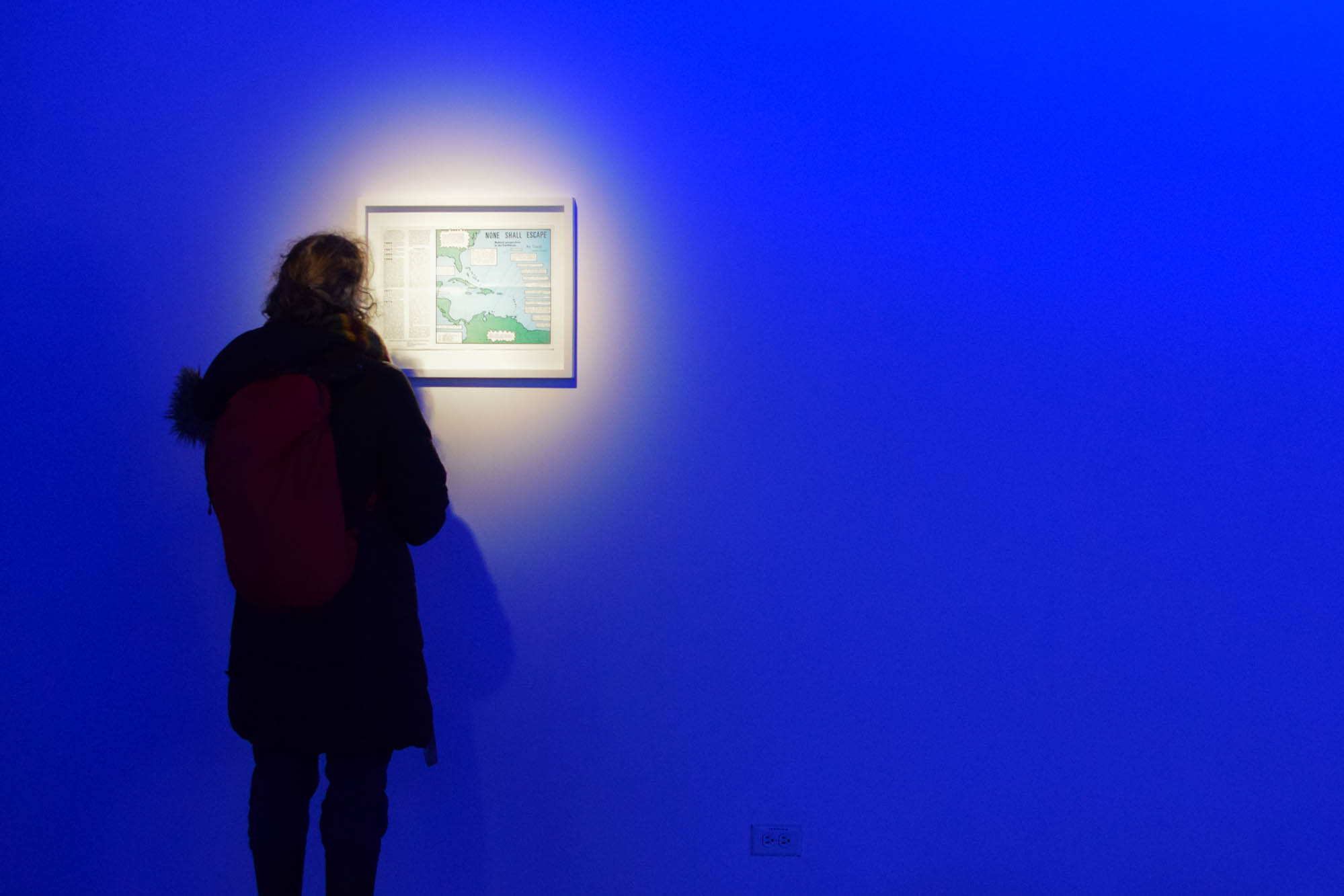Shedding light on obscured narrative in colonialism history
The reflection of a rich shade of blue graces Concordia University’s library building. Written in all caps, the word “AMERIKKKKK…KKKKANADA” is at the forefront of the exhibition, on the Leonard & Bina Ellen Art Gallery’s window display.
This unusual lighting is part of the gallery’s newest exhibit by Vincent Meessen, curated by Director Michèle Thériault, Blues Klair.
Meessen is an American artist, born and raised in Baltimore, who currently lives and works in Brussels, Belgium. He was representing Belgium in 2015 at the 56th Venice Biennale in a group exhibition entitled Personne et les autres (No One and Others) when he met Thériault. Thériault was genuinely taken by the artist’s passion for history and colonialism, and colonial modernity in the Western imaginary.
“What was interesting in him was the piece he presented,” Thériault said, “which addressed the traces of colonialism or coloniality, if you want, in modernity, but also where he kind of diffused the notion of authorship by not doing a single artist proposition. He worked in conjunction with a bunch of different artists.”
The 2015 Biennale exhibition traditionally showcases individual artists and their works, but Meessen chose to go beyond that, and work collectively with 10 artists from four continents.
“I was very fascinated by his piece,” Thériault continued, “which, to make a long story short, was a film installation within an environment that he created, shot in Congo. He was also working with someone, a Congolese who had been a situationist in the 60s, and Meessen worked with him to showcase his work. I was very much fascinated by how he exposed the traces of colonialism.”
Blues Klair is the artist’s first solo exhibition in North America.
Meessen and Thériault coordinated for two years before this project came to life. Meessen is a founding member of Jubilee, a platform for artistic research and production. Thériault got in contact with Jubilee, and the connection was formed.
At the heart of Blues Klair, a video plays. The “narrated exhibition,”—as described by the gallery—titled Ultramarine is a 42-minute set by Kain the Poet, who was part of the Black Arts Movement towards the end of the 60s. The film is linked to Meessen’s commissioned piece for the city of Toulouse’s yearly art festival called Printemps de septembre.
Kain the Poet, born Gylan Kain in Harlem, New York City, is also a playwright and actor. He now lives in Amsterdam, and is considered one of the precursors to hip hop, as his spoken words in beat culture focus mainly on black power.
In Ultramarine, Kain is seen and heard breaking racial barriers, and calling out European mistreatment towards people of colour. He talks about his own experience in exile in Amsterdam, and the trade of the Indigo plant in the 1700s.
“Blue is important in Toulouse,” Thériault explained. “It’s the city that used pastel, a dye—you make dye out of pastel—usually supplied by the Indigo plant. Indigo is grown in Indonesia and some parts of the Caribbean, so in Toulouse, trading and commerce were very present. The trading also has to do with slave roots and the labourers. There’s the question of slavery and exploitation raised in that film, as well as the question of the blues, seeing as Kain is Afro- American.”
Blues Klair also sheds light on an event seldom discussed at Canadian schools: the 1968 Sir George Williams affair, which took place on the Sir George Williams campus, now known as part of Concordia University. When six Caribbean students accused a biology professor of racism towards black students—after the lecturer was handing out failing grades to all students of colour, regardless of their work—the students demanded the university investigate these charges and form a committee that would represent the black community.
The exposition showcases flyers upon flyers scattered across the gallery floor, commemorating the events that happened and the violence Concordia University’s campus has witnessed. Furthermore, this installation serves as a reminder of black power, and how resilient and strong people can be when they stand up for their beliefs.
Vincent Meessen’s exposition will be on display at the Leonard & Bina Ellen Art Gallery in the LB building until Feb. 23.
